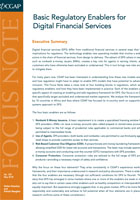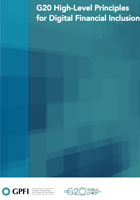
This note documents the experience of several countries that leveraged these tools under the Financial Inclusion Support Framework (FISF) program. FISF is a World Bank Group initiative that aims to accelerate and increase the effectiveness of reforms and other country-led actions to achieve national financial inclusion goals. In this context, FISF has supported, to varying degrees, the digitization of government payments in Côte d’Ivoire, Indonesia, Mozambique, Vietnam, and Zambia. The rest of the note is structured as follows: Section II covers a survey of retail payment costs conducted in Pakistan. Section III documents the government payment mapping exercise undertaken in Côte d’Ivoire, while section IV discusses the resulting roadmap for implementation. Section V presents some implementation challenges and learnings in digitizing government payments in FISF countries.
The report discusses key policy issues that enable and constrain digital savings market development and offers policy considerations within the context of the G20’s High-Level Principles for Digital Financial Inclusion. Based on current market observations, three policy considerations seem most important for facilitating digital savings account deployments: Enable banking institutions to pursue digital savings partnerships with nonbank entities. Support the development of interoperability between banks and nonbank e-money issuers. Harmonize customer due diligence standards for emoney wallets and low-risk bank deposits
This report presents the main findings of the 2017 Global Financial Inclusion & Consumer Protection (FICP) Survey. The 2017 Global FICP Survey tracks the prevalence of key policy, legal, regulatory, and supervisory efforts to advance financial inclusion and financial consumer protection. Financial sector authorities in 124 jurisdictions - representing 141 economies and more than 90 percent of the world’s unbanked adult population - responded to the 2017 Global FICP Survey. See also: 2013 Global CPFL Survey (available below).
China has achieved remarkable success in financial inclusion. China’s rate of account ownership – a basic metric of financial inclusion – has increased significantly in the past two decades and is now on par with that of other G-20 countries. Traditional financial service providers have dramatically increased the reach of the formal financial sector, including through the world’s largest agent banking network. China has also been an established leader in the fintech revolution, with new technology-driven providers transforming how millions of Chinese consumers make payments, borrow, save, invest, and insure themselves against risk. Download (PDF) »
The Agenda offers a framework for the consideration of high-level issues by individual member countries, including in their own domestic policy discussions. It does not represent the work program of the IMF or the World Bank, nor does it aim to provide specific guidance or policy advice. The Agenda will help guide the focus of IMF and World Bank staff in their work on fintech issues within their expertise and mandate, inform their dialogue with national authorities, and help shape their contributions to the work of the standard-setting bodies and other relevant international institutions on fintech issues. Implications for the work programs of the IMF and World Bank will be developed and presented to their respective Executive Boards for guidance as the nature and scope of the membership’s needs––in response to the Bali Fintech Agenda—become clearer

It has been more than 10 years since CGAP first studied emerging financial services models that use agents as alternative delivery channels and digital technology to connect customers to their financial services providers. We have been exploring the potential to advance financial inclusion through what was then called branchless banking, but nowadays is better known as digital financial services (DFS). What started off as a niche topic is now part of the mainstream of financial inclusion. From the beginning, the creation of an enabling regulatory framework was thought to be one of the drivers of success for DFS.

Digital technologies offer affordable ways for the financially excluded—the majority of whom are women— to save for school, make a payment, get a small business loan, send a remittance, or buy insurance. The 2010 G20 Principles for Innovative Financial Inclusion spurred initial efforts and policy actions. These 2016 High Level Principles for Digital Financial Inclusion build on that success by providing a basis for country action plans reflecting country context and national circumstances to leverage the huge potential offered by digital technologies